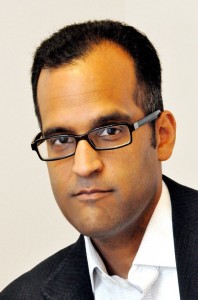Beyond gel-to-gel combat: A high(er)-throughput platform for quantifying matrix biophysical control of cell behavior
It remains extremely challenging to dissect the cooperative influence of multiple extracellular matrix parameters on cell behavior. This stems in part from a lack of easily deployable strategies for the combinatorial variation of matrix biochemical and biophysical properties. Here we describe a simple, high-throughput platform based on light-modulated hyaluronic acid hydrogels that enables imposition of mutually independent and spatially continuous gradients of ligand density and substrate stiffness. We validate this system by showing that it can support mechanosensitive differentiation of mesenchymal stem cells. We also use it to show that the oncogenic microRNA, miR18a, is nonlinearly regulated by matrix stiffness and fibronectin density in glioma cells. The parallelization of experiments enabled by this platform allows condensation of studies that would normally require hundreds of independent hydrogels to a single substrate. This system is a highly accessible, high-throughput technique to study the combinatorial variation of biophysical and biochemical signals in a single experimental paradigm.
Bio
 Sanjay Kumar, M.D., Ph.D., is Professor and Associate Chair of Bioengineering at the University of California, Berkeley. He earned a B.S. in Chemical Engineering (1996) from the University of Minnesota, followed by an M.D. (2003) and Ph.D. in Molecular Biophysics (2003) from Johns Hopkins University. Following an NIH Research Fellowship at Children’s Hospital Boston and Harvard Medical School, he joined the faculty at UC Berkeley in 2005. Dr. Kumar and his research group have been fortunate to receive a number of honors, including the Presidential Early Career Award for Scientists and Engineers (PECASE), The NIH Director’s New Innovator Award, The Arnold and Mabel Beckman Young Investigator Award, the NSF CAREER Award, and the Stem Cells Young Investigator Award. He was recently elected a Fellow of the American Institute for Medical and Biological Engineering (AIMBE) and appointed a Standing Member of the NIH Study Section on Intercellular Interactions (ICI).
Sanjay Kumar, M.D., Ph.D., is Professor and Associate Chair of Bioengineering at the University of California, Berkeley. He earned a B.S. in Chemical Engineering (1996) from the University of Minnesota, followed by an M.D. (2003) and Ph.D. in Molecular Biophysics (2003) from Johns Hopkins University. Following an NIH Research Fellowship at Children’s Hospital Boston and Harvard Medical School, he joined the faculty at UC Berkeley in 2005. Dr. Kumar and his research group have been fortunate to receive a number of honors, including the Presidential Early Career Award for Scientists and Engineers (PECASE), The NIH Director’s New Innovator Award, The Arnold and Mabel Beckman Young Investigator Award, the NSF CAREER Award, and the Stem Cells Young Investigator Award. He was recently elected a Fellow of the American Institute for Medical and Biological Engineering (AIMBE) and appointed a Standing Member of the NIH Study Section on Intercellular Interactions (ICI).
